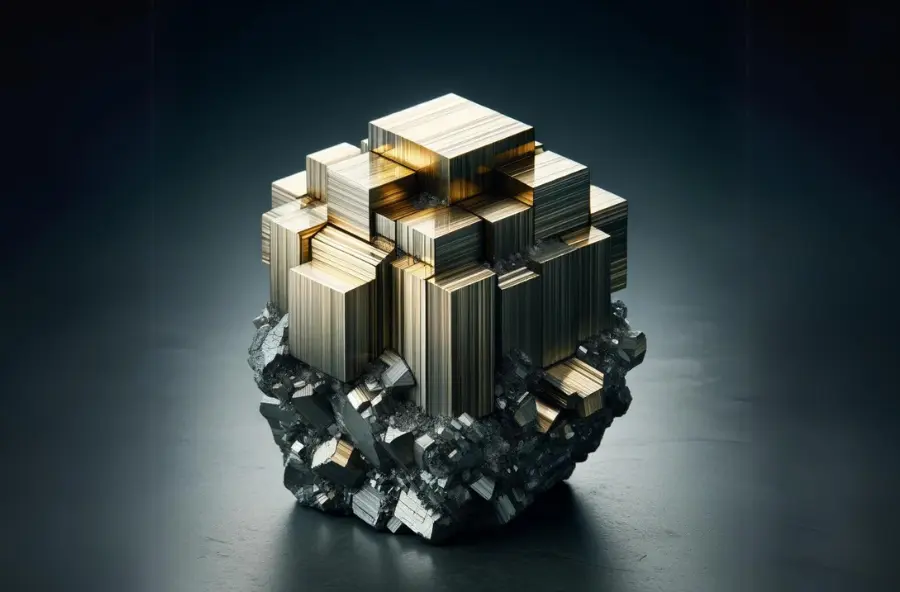Introduction
Pyrite, often mistaken for gold by prospectors, has earned the moniker “Fools Gold” due to its deceptive appearance. However, this mineral is far from being just a mere impostor of gold. It holds a unique place in both the mineral world and the mining industry. This blog post delves into the fascinating world of pyrite, unraveling its true properties, diverse uses, and its significant role in mining.
The History of Pyrite (Fools Gold)
Pyrite’s history dates back to ancient civilizations. The Greeks, Romans, and Incas were among the first to document and utilize this mineral. The term “pyrite” is derived from the Greek word “pyr,” meaning fire, as it sparks when struck against metal or stone. This property made it a valuable tool in the early days for starting fires.
In the Middle Ages, pyrite was used in jewelry, mistakenly thought to contain gold. This misconception persisted until the 19th century during the gold rushes in California and Australia, where its similarity to gold led many prospectors to believe they had struck it rich, only to realize they had been fooled by pyrite.
What is Pyrite or Fools Gold?
Pyrite, with its chemical composition of iron sulfide (FeS2), is much more than just a doppelganger for gold. This naturally occurring mineral is a classic example of how appearances can be deceiving in the world of geology. Often found in a variety of geological formations, pyrite’s habitats range from sedimentary rocks, where it forms in low-temperature environments, to magmatic deposits, and even in coal beds and as a replacement mineral in fossils.
Its formation is a fascinating process. Pyrite often crystallizes in environments where there is a significant amount of iron and sulfur. These elements combine under various conditions, including hydrothermal, sedimentary, and metamorphic environments, to form this mineral. In some cases, pyrite forms in the absence of oxygen, which prevents the iron from forming more common iron oxides and instead pairs with sulfur.
Properties and Identification of Fools Gold
Pyrite, commonly known as “Fools Gold,” is renowned for its unique properties that distinguish it from true gold and other minerals.
- Chemical Composition: Pyrite is composed of iron and sulfur, with a chemical formula of FeS2. This composition is consistent across various samples, contributing to its predictable properties.
- Crystal Structure: Pyrite crystallizes in the isometric system. This means it forms in a cubic shape, which is one of its most distinctive and recognizable features. The crystals can appear as perfect cubes, pyritohedra (twelve-faced forms), or octahedra. The uniformity and symmetry of these crystals are remarkable in the mineral world.
- Color and Luster: Pyrite is famous for its metallic luster and pale brass-yellow hue, which is strikingly similar to gold. However, unlike gold, which is malleable and ductile, pyrite is brittle and will break or crumble when struck or scratched.
- Hardness and Specific Gravity: On the Mohs scale of mineral hardness, pyrite scores around 6 to 6.5, making it harder than other common minerals. Its specific gravity is approximately 4.8 to 5.0, which is higher than most other sulfide minerals.
- Streak and Fracture: Pyrite leaves a greenish-black streak when rubbed on a white porcelain streak plate, unlike the yellow streak of gold. Its fracture is uneven, producing small, conchoidal (shell-like) fragments.
- Magnetic Properties: While pure pyrite is not magnetic, it can contain minor amounts of nickel or cobalt, imparting weak magnetic properties. Additionally, pyrite can become more magnetic through heating.
- Thermal Conductivity: Pyrite is a good conductor of heat and electricity, which is characteristic of most metallic minerals.
- Reactivity with Air and Water: Pyrite is susceptible to oxidation when exposed to air and moisture. This reaction can lead to the formation of sulfuric acid and iron oxides, often resulting in acid mine drainage, an environmental concern in areas where pyrite is mined or disturbed.
Industrial Uses
Despite its reputation as “Fools Gold,” pyrite has several industrial uses. It’s a source of sulfur dioxide, which is essential in the paper industry and in the manufacture of sulfuric acid. Additionally, during the early 20th century, pyrite was used as a mineral detector in radio receivers.
Significance in the Mining Industry
In the mining world, pyrite is often associated with valuable ore deposits. It’s commonly found near gold and copper; hence, its presence can indicate the potential for these more valuable metals. Moreover, pyrite is used in the process of heap leaching in gold mining. The mineral, when exposed to oxygen and water, decomposes and releases acids that help liberate gold from its ore.
Environmental Impact
The mining and processing of pyrite can lead to environmental challenges. When pyrite is exposed to air and water, it forms sulfuric acid and iron hydroxide, leading to the formation of acid mine drainage (AMD). This is a significant environmental concern in mining areas, as it can lead to the contamination of groundwater and surface water.
Conclusion
Pyrite’s role as “Fools Gold” is just a small part of its story. This mineral’s unique properties, industrial applications, and significance in the mining industry make it a subject of great interest and importance. Its presence in mineral deposits can guide mining operations and its uses in various industries showcase its versatility beyond just being a gold lookalike.
To explore more about the wonders of minerals and their impact on our world, stay tuned to Kings Mines blog. For those passionate about mineral collection or the mining industry, Kings Mines offers a wealth of information and products. Don’t forget to share this post and join our community of mineral enthusiasts!

